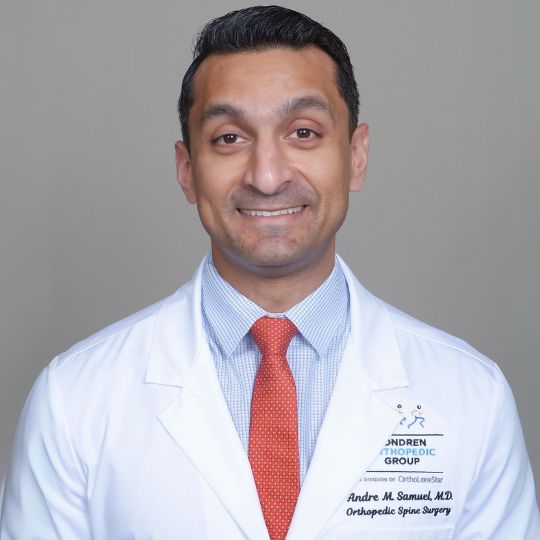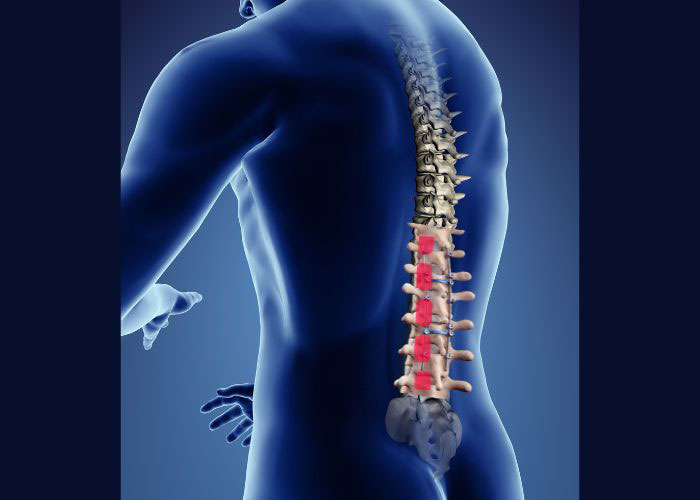Failed Hardware – Complex Revision Surgeon
On occasion, spinal fusion may not alleviate your back pain, especially if the hardware had failed or if you have a spinal deformity. If you are dealing with a complicated spine issue or a failed surgery it’s crucial to see an experienced surgeon like Doctor Andre M. Samuel, serving Clear Lake, Houston, and Sugar Land, TX. He specialized in complex revision anterior-posterior thoracolumbar fusion for hardware failures and spinal deformities. Contact Dr. Samuel’s team today!

What is a complex revision thoracolumbar fusion?
A complex revision thoracolumbar fusion is a surgical procedure where the surgeon re-operates on a previously fused section of the spine in the thoracolumbar region (middle and lower back area.) This type of a complex revision is used to correct complications that may have arisen from a previous surgery, such as broken or loosening hardware, poor spinal alignment/posture, and progressive disc degeneration. Surgery of this nature is highly technical and requires a surgeon who is specially trained for complex revisions. Doctor Andre M. Samuel has the training and experience in complex revision thoracolumbar fusion and takes care of patients in the Clear Lake, Houston and Sugar Land areas of Texas.

Where is the thoracolumbar region?
This is the area of the back that involves the middle and lower portions of the spine. That may include one or more vertebra of the thoracic spine (T1-T12) and one or more vertebra in the lumbar spine (L1 – L5). This area is important to spinal stability, because it is responsible for holding most of the upper body’s weight. The thoracolumbar region of the spine provides mobility and flexibility to the spine.
Why would I need a revision of a previous thoracolumbar fusion?
A revision surgery of a previous thoracolumbar fusion might be necessary if the patient is experiencing pain that continues to get worse and is limiting mobility. Other reasons Dr. Samuel may suggest a revision surgery may include:
- Failed hardware: One of the components breaks from the previous surgery.
- Non-Union: When the two vertebra do not fuse together as was intended.
- Adjacent segment degeneration: When the vertebra above or below the original surgery break down and become unstable
- Infection
- Deformity: Often seen in scoliosis patients.
- Scar tissue
- Improper placement of hardware: can lead to further instability.
What does Anterior-Posterior mean?
The Anterior-Posterior approach refers to how Dr. Samuel accesses the spinal repair. Anterior means “front,” where a revision would take place with the incision in the abdomen or chest, moving in to remove diseased discs, correct deformities and place bone grafts. Posterior means “back” where a revision would take place with the incision occurring in the back to place screws, replace rods and assess hardware.
The dual approach of anterior-posterior ensures that all aspects of the correction are completed in the best possible surgical position and access point(s).
How is a complex/revision anterior-posterior thoracolumbar fusion done?
Dr. Samuel typically preforms this highly technical, specialized surgery through the anterior and posterior approaches. He will assess and remove any damaged discs or other materials and replace them with bone grafts, interbody devices, rods, screws, or other surgical tools that will help with the revision. The goal of this revision is to correct any misalignment, replace broken hardware, and stabilize the spine to prevent further issues with deformity or degeneration.
What is the recovery like after a complex revision of a thoracolumbar fusion?
Recovery after a complex revision anterior posterior thoracolumbar fusion can vary greatly depending on the age and general health of the patient. The extent of surgery performed by Dr. Samuel can also have an effect on the recovery time-line. In general, patients can expect the following:
- Extended postoperative hospitalization, often for a week or longer
- Several months of limited mobility, allowing the bones to fuse and heal
- Extreme caution avoiding falls, sudden twisting and other harmful movements.
- Intense pain management
- Hospital stay
- Gradual progression to physical therapy
- Frequent doctor visits and further testing which may include x-ray, MRI or CT-Scan



